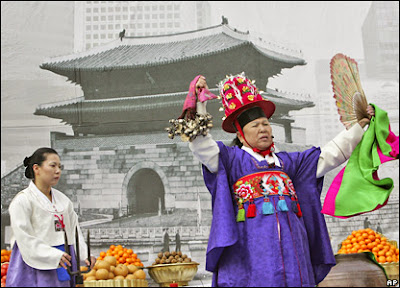Dr. Yang Jongsun, a long-standing member of the shamanist community in Korea, has worked closely with shamans around Korea studying their craft as both practitioner and scholar. He earned his PhD in folklore from Indiana University, Bloomington, and has written articles and books which document and analyze Korean shamanism. As former senior curator at the National Folk Museum, Dr. Yang built up their collection and added public programming focusing on shamanism. He is also President of the Korean Society for Shamanism Studies, and has a large amassed personal collection on Korean shaman materials.
During his lecture, he was assisted by two shamans -- Ji Gan-nan (born 1945) and Lee You-jin (born 1955) whose relationship is spiritual mother-spiritual daughter. Ji Gan-nan became a shaman when she was 9 years old when she had possession and was diagnosed with the shamanic disease "sin-byoung" (the possession sickness). Her spiritual daughter had her initiation ritual as a shaman when she was 32 years old, and since that time has been the spiritual daughter of Ji Gan-nan. Together they work together in both their shamanic practice and in business.
In the lecture, Dr. Yang shared some interesting and little-known facts about Korean shamanism. As is commonly known, shamanism has been somewhat repressed in development since the age of computers and advanced scientific technology in Korea; however, it still is used when initiating business. One example is having an exorcism of bad spirits from the building grounds and requests for blessings on the success of the new business. There are guestimated 300,000 Korean shamans in South Korea, although the Korean government denies the existence of these shamans. Among that number, about 25% of them are male shamans, which is definitely different than in traditional Korean society when the majority of shamans were women. The large number of women predominating as shamans in traditional society probably was influenced by so few acceptable jobs being available for women, especially women working outside of the home, and being a shaman gave not only a job but was socially acceptable and in some, perhaps many, cases a respectable position.
 |
| Picture taken from "Korean Shamanism and Picking the Date" on the blog "In Yeon" (a unique word for "destiny" |
Basically, there are two types of shamans. The 강신무 and the 세슴무당. The 강신무 is a person who experiences 신병, the shamanic disease of possession, and is the most common type of shaman. Sometimes they are called the "disease shaman" but caution needs to be taken when translating the word disease (as well as exorcism and possession) as all three of these words do not take the highly negative connotations that are felt when using the English words. The name "disease shaman" is more of a labeling on how the person became a shaman and suggests his or her right to heredity or experience as a shaman. The other type of shaman, the 세슴무당, is one who was born as a shaman and so learned their "performing arts" from birth. In other words, they are like a heritage shaman. As said, traditionally shamans or 무당 were women and the 세슴무당 were based on matrilineal inheritance.
Here's a look at shamanism on Jeju Island, as well as a book coming out on shamanism there - http://www.myseoulsearching.com/2015/05/an-interview-with-joey-rositano.html
ReplyDelete